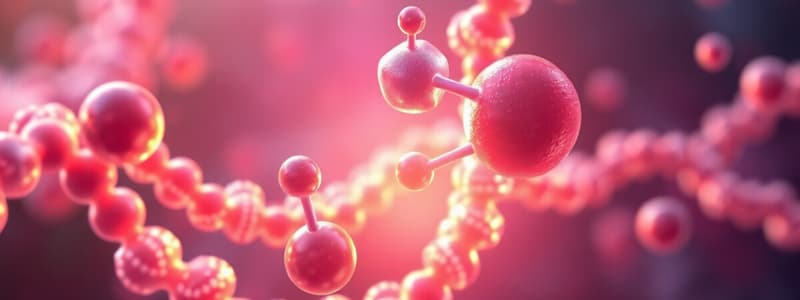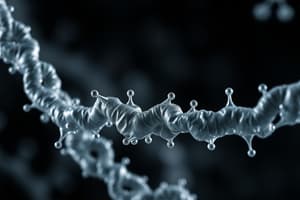Podcast
Questions and Answers
Proteins are made up of carbon, hydrogen, oxygen, nitrogen, and sulfur.
Proteins are made up of carbon, hydrogen, oxygen, nitrogen, and sulfur.
False (B)
Amino acids are the monomers that combine to form proteins.
Amino acids are the monomers that combine to form proteins.
True (A)
Nucleic acids include DNA and RNA, which are responsible for genetic information.
Nucleic acids include DNA and RNA, which are responsible for genetic information.
True (A)
The polymer of nucleotides is ATP, which serves as a genetic code.
The polymer of nucleotides is ATP, which serves as a genetic code.
Liquid fats at room temperature include mainly animal-based oils and saturated fats.
Liquid fats at room temperature include mainly animal-based oils and saturated fats.
Carbohydrates provide 9 kilocalories per gram when consumed.
Carbohydrates provide 9 kilocalories per gram when consumed.
Monosaccharides are the building blocks of carbohydrates.
Monosaccharides are the building blocks of carbohydrates.
Glycogen is primarily used for energy storage in plants.
Glycogen is primarily used for energy storage in plants.
Chitin is found in the cell wall of some fungi.
Chitin is found in the cell wall of some fungi.
Saturated lipids contain at least one double or triple bond between carbons.
Saturated lipids contain at least one double or triple bond between carbons.
Flashcards
Carbohydrate monomer
Carbohydrate monomer
A single sugar molecule, also known as monosaccharide. Glucose is a common example.
Types of Polysaccharides
Types of Polysaccharides
Complex carbohydrates formed by linking many monosaccharides together. Examples include starch, glycogen, cellulose, and chitin.
Lipids are...
Lipids are...
Essential fats that store energy, insulate the body, and form cell membranes.
Saturated fats
Saturated fats
Signup and view all the flashcards
Unsaturated fats
Unsaturated fats
Signup and view all the flashcards
What does protein do?
What does protein do?
Signup and view all the flashcards
What are the building blocks of protein?
What are the building blocks of protein?
Signup and view all the flashcards
What elements make up protein?
What elements make up protein?
Signup and view all the flashcards
What is the function of nucleic acids?
What is the function of nucleic acids?
Signup and view all the flashcards
What are the building blocks of nucleic acids?
What are the building blocks of nucleic acids?
Signup and view all the flashcards
Study Notes
Biology 8 - Unit 02: Life Processes of Living Things - Biomolecules
- The unit focuses on biomolecules, including carbohydrates, lipids, nucleic acids, and proteins.
- Living things need biomolecules for various processes such as energy storage, providing structure, and controlling chemical reactions.
- Biomolecules are organic compounds, largely composed of carbon, hydrogen, oxygen, nitrogen, and phosphorus.
Carbohydrates
-
Carbohydrates are the most common organic molecules, providing the main energy source to the body.
-
The chemical structure is C, H, O (1:2:1 ratio)
-
Monosaccharides are the basic building block (glucose, fructose)
-
Disaccharides are two monosaccharides combined (maltose, sucrose).
-
Polysaccharides such as starch (plant energy storage), glycogen (animal energy storage), cellulose (structural support in plants, found in cell walls), and chitin (found in exoskeletons of insects and some fungi).
Lipids
- Lipids store energy, insulate the body, and are a major component of cell membranes.
- Lipids are hydrophobic (do not dissolve in water)
- The chemical structure is largely composed of C, H, O. The proportion of hydrogen to carbon atoms is greater than in carbohydrates.
- The basic building block is glycerol and 3 fatty acids.
- The main types are phospholipids, triglycerides (fats and oils), steroids (e.g., cholesterol), and waxes.
- Saturated fats have single bonds between carbon atoms, are solid at room temperature (largely animal fats).
- Unsaturated fats have double or triple bonds between carbon atoms, are liquid at room temperature (largely plant-based fats).
Proteins
- Proteins are essential for transporting molecules into and out of cells, controlling chemical reactions, providing for structure and growth.
- Proteins are made up of amino acids (20 different ones).
- Examples of proteins include hemoglobin (in red blood cells), albumin (in eggs), enzymes, and antibodies.
Nucleic Acids
- Nucleic acids, such as DNA and RNA, provide genetic information, and instruct the body on how to make proteins.
- A nucleotide is the most basic building block of Nucleic Acids. A nucleotide consists of a sugar, phosphate, and nitrogenous base.
- Elements include: C, H, O, N, and P
- Found in DNA, RNA, ATP
Summary
- These biomolecules are essential for life's processes.
- Each biomolecule has a specific structure and function in the body.
Studying That Suits You
Use AI to generate personalized quizzes and flashcards to suit your learning preferences.



